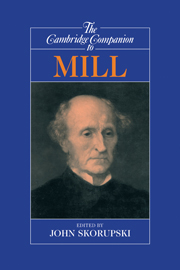Book contents
- Frontmatter
- Introduction
- 1 Mill on language and logic
- 2 Mill, mathematics, and the naturalist tradition
- 3 Mill on induction and scientific method
- 4 Mill, phenomenalism, and the self
- 5 Mill on religion
- 6 Mill on psychology and the moral sciences
- 7 Mill's utilitarianism
- 8 Mill's political economy
- 9 Civilization and culture as moral concepts
- 10 Democracy, socialism, and the working classes
- 11 The subjection of women
- 12 Mill and the Classical world
- 13 The reception and early reputation of Mill's political thought
- 14 Mill in a liberal landscape
- Guide to further reading
- Bibliography
- Index
2 - Mill, mathematics, and the naturalist tradition
Published online by Cambridge University Press: 28 May 2006
- Frontmatter
- Introduction
- 1 Mill on language and logic
- 2 Mill, mathematics, and the naturalist tradition
- 3 Mill on induction and scientific method
- 4 Mill, phenomenalism, and the self
- 5 Mill on religion
- 6 Mill on psychology and the moral sciences
- 7 Mill's utilitarianism
- 8 Mill's political economy
- 9 Civilization and culture as moral concepts
- 10 Democracy, socialism, and the working classes
- 11 The subjection of women
- 12 Mill and the Classical world
- 13 The reception and early reputation of Mill's political thought
- 14 Mill in a liberal landscape
- Guide to further reading
- Bibliography
- Index
Summary
John Stuart Mill's views about arithmetic and geometry have probably attracted more ridicule and disdain than the positions of any other thinker in the history of the philosophy of mathematics. I believe that the unfavorable assessment of Mill is quite unwarranted, resting in part on misunderstandings of his position born of hasty misreading (sometimes, one suspects, of reading only the scornful remarks of his influential critics), in part on commitments to a view of philosophy quite different from that which moved Mill. In this chapter I shall try to set the record straight.
Because it is essential to any clear appreciation of Mill's ideas about mathematics to recognize the problems he attempted to address, we should begin by contrasting two large conceptions of philosophy in general and of the philosophy of mathematics in particular. One of these conceptions, which I shall call “transcendentalism”, believes that a central task of philosophy is to identify fundamental conditions on human thought, representation, or experience, and that this enterprise is to be carried out by special philosophical methods that yield knowledge quite independently of experience or of the deliverances of the natural sciences. Prime examples of transcendentalist philosophy can be found in Kant, in Frege, and, in recent philosophy, in the writings of Michael Dummett.
- Type
- Chapter
- Information
- The Cambridge Companion to Mill , pp. 57 - 111Publisher: Cambridge University PressPrint publication year: 1998
- 6
- Cited by

